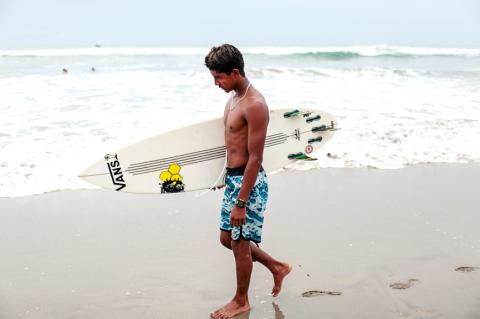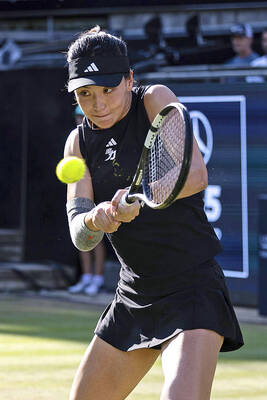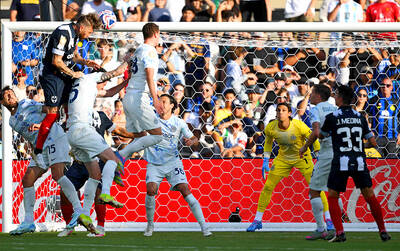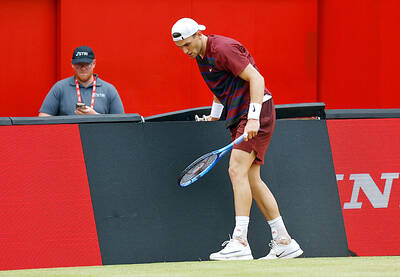Luis Rey Hernandez feels safe and happy when he is on his surfboard, riding waves off the shores of Acapulco.
However, when he is not inside the barrel of a wave, the 17-year-old surfer has to navigate the rough streets of the resort city on Mexico’s Pacific coast.
Hernandez, a rising star who in June became national champion in the under-18 category and is known as “The King,” has heard shootouts. He once saw a body lying on the street.

Photo: AFP
“The violence in Acapulco is very bad. The government, the president — they do nothing. We’re going down the wrong path, because we hear gunshots, [we see] dead people,” Hernandez said as he stood with his surfboard on sandy Revolcadero beach after catching some waves.
“You’re always afraid to leave your house,” said the fit teenager, whose black hair has reddish locks from sun exposure. “At sea, I’m not afraid. I feel happy there.”
Acapulco is famous for its cliff divers, who wow visitors with daring drops into the ocean.
However, surfing has gained popularity among youths in neighborhoods worn down by poverty and merciless drug violence that have turned the city into Mexico’s murder capital.
Javier Hernandez Castanon, the 58-year-old president of the Guerrero State Surfing Association, said gringos brought the sport to Acapulco in the 1960s, at a time when the city was popular among Hollywood stars.
“Since we didn’t have surfboards, we started surfing on car [tire] inner tubes, and then on wood trunks. The boards began to arrive in the 1970s,” said Hernandez Castanon, who is known as “La Charra” and is Luis Rey Hernandez’s uncle.
The surf association had 50 registered members in Acapulco in the 1960s, growing to more than 200 in the 1990s and more than 700 today.
However, the veteran surfer said the crime wave “affects surfing, because violence is unfortunately attracting every youth.”
“We need support to attract young people to surf, something different,” Hernandez Castanon said.
Three of his four children migrated to Chicago 12 years ago after they were threatened by a gang demanding a tax on their beach gear rental business.
Two cartels are fighting over local drug sales in the city. More than 1,300 people have been murdered since last year, including three on the beach this year.
Jose Manuel Trujillo, a local star known as “Yuco,” said that without surfing, he might have been dragged into the gang underworld like some of his friends in his district of Tres Palos.
Three of his friends were killed in their teens.
“They are young people who lack education and poverty takes them down that path, the easiest one,” 29-year-old Trujillo said. “Thanks to surfing, I stayed away from that path.”
Wearing a hat from his sponsor, energy drink maker Monster, and sporting a smile dotted with braces, Trujillo now tours the world, sells his own T-shirt brand on the beach or on the Internet, and even got a role in the Hollywood shark thriller The Shallows starring Blake Lively.
“Yuco” and his brother-in-law “The King” participated at the Vans Surf Open Acapulco competition last month, an international event that attracted about 100 surfers from around the world.
However, event director Gustavo Duccini said some surfers stayed away after the US Department of State issued a travel warning in April that barred US government employees from visiting the city.
“It’s exaggerated, but it has repercussions,” Duccini said.
Hernandez finished second in the junior category behind Oaxaca state’s Jhony Corzo at the competition.
The Mexican Surfing Federation called them “the two best youths in the country.”
Hernandez wants to surf his way out of town.
“I’d like to live in another country that’s calmer, where one can go out for a walk,” said Hernandez, who has surfed since he was nine. “There are good waves in Hawaii. There’s almost no violence.”
While he is sponsored by Vans, the skater shoe company, getting money to compete abroad is still a struggle for a teenager whose father earns a living by renting out a Jet Ski and other gear at the beach.
Other budding and accomplished surfers from Acapulco face similar financial hurdles. A child’s surfboard can cost at least US$240 at a local shop.
Despite the costs, the family of Gaciel Garcia, a sturdy 10-year-old boy, backs his dream of going professional.
His father, Leonel Garcia, helped him ride his first waves at age four, holding the board to launch his son.
Gaciel Garcia now spends four hours per day in the water after school and homework.
His father whistles from the beach to point out waves and moves his hand up and down to encourage his son to use a bouncing technique to gain speed.
Gaciel Garcia’s work paid off in June, when he won the under-12 competition in Baja California, where Hernandez, his cousin, also triumphed.
Local surf shops partly sponsored the trip, but the family needs more help to take him to tournaments abroad.
“I told him I think this sport is for rich people,” his mother, 39-year-old Vianey Gallardo, said while grilling chicken at her small restaurant called Pollos Surf.
Gallardo wants the family to move to a safer beach town, where Gaciel Garcia can continue the sport, “because things are a little ugly in Acapulco.”

Twelve days after winning her second Grand Slam title at the French Open, Coco Gauff fell at the first hurdle on grass in Berlin on Thursday as beaten Paris finalist Aryna Sabalenka advanced to the quarter-finals. Recipient of a first round bye, American Gauff lost 6-3, 6-3 to Chinese qualifier Wang Xinyu as world number one Sabalenka beat Rebeka Masarova 6-2, 7-6 (8/6) in her second round tie. Winner of 10 main tour titles, including the US Open in 2023 and the WTA Finals last year, Gauff has yet to lift a trophy in a grass-court tournament. “After I won the first

Sergio Ramos on Tuesday outfoxed two Inter players and artfully headed home the first goal for Monterrey at the FIFA Club World Cup. The 39-year-old Ramos slipped through the penalty area for the score just as he did for so many years in the shirts of Real Madrid and Spain’s national team, with whom he combined smarts, timing and physicality. Ramos’ clever goal and his overall defensive play at the Rose Bowl were major factors in Monterrey’s impressive 1-1 draw against the UEFA Champions League finalists in the clubs’ first match of the tournament. “There is always a joy to contribute to the

Top-ranked Aryna Sabalenka staged a “crazy comeback,” saving four match points before beating Elena Rybakina 7-6 (6), 3-6, 7-6 (6) in the quarter-finals of the Berlin Open on Friday. Sabalenka was 6-2 down in the final-set tie-breaker, but won six straight points to reach her eighth semi-final of the season. “Elena is a great player and we’ve had a lot of tough battles,” Sabalenka said. “I have no idea how I was able to win those last points. I think I just got lucky.” “I remember a long time ago when I was just starting, I won a lot of matches being down

While British star Jack Draper spent the past week trying to find rhythm and comfort in his first grass tournament of the season at the Queen’s Club Championships in London, Jiri Lehecka on Saturday bulldozed everything in his path. After more than two furious hours of battle, their form was reflected in the final scoreline as Lehecka toppled a frustrated Draper, the second seed, 6-4, 4-6, 7-5 to reach the biggest final of his career, against Carlos Alcaraz. Lehecka is also the first Czech to reach the men’s title match at Queen’s since Ivan Lendl lifted the trophy in 1990. Draper, who